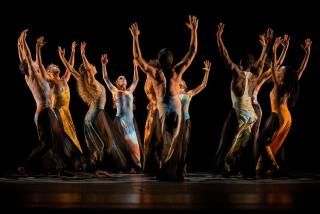The Push and Pull Between Inventing and Preparing
- Share via
Imagine you’re in an arena opposite Jean-Claude Van Damme, Russell Crowe or Jackie Chan. But instead of being beaten senseless, you’re swept up into a gymnastic body ride: being lifted onto and then rolling off your partner’s back into a horizontal hold and then down to the floor where you become the lifter and the collaboration takes new and ever-unpredictable paths.
That’s Contact Improvisation, an experimental, egalitarian technique now nearing its 30th birthday that influences much of contemporary choreography and shapes a generation’s ideal of the freed, energized, articulate body.
The deep communicative glories of CI were briefly on view during a multicompany festival at Highways Performance Space on Friday, but much of the evening showed the technique going the way of improvisational comedy--toward the glib and superficial.
In her opening remarks, curator Shel Wagner emphasized that each performing group had to improvise according to a “score” or set of specific tasks and conditions outlined in the program booklet. (“Everyone walks between everyone else,” for instance.) In theory, a score can challenge performers and serve as a kind of safety net: giving them an agenda to follow even when inspiration doesn’t strike.
Unfortunately, too many of the scores on Friday discouraged physical contact and too many others discouraged true improvisation. The uneventful “#1” women’s quartet by the Off the Hip ensemble, for example, featured only fleeting, rudimentary contact and lots of attempts to simulate modern dance choreography.
But even the most impressive CI-style dancing often proved alarmingly score-controlled. Although Wagner had promised the audience that “no one knows what’s going to happen next,” her own “TBA” duet with Stefan Fabry was so extensively talked through in advance--the moves, the sequencing, the accompaniment, even the options for repeating passages that didn’t go as planned--that the performance never qualified as improvisational, merely unrehearsed.
Was their larger scale piece “in-be-t-wee-n” just as preset? Who knows? They’d shared their agenda for “TBA” with the audience--and members of that audience kept objecting to their violation of the key CI imperative: Make it up as you go along. But the planning for “in-be-t-wee-n” happened offstage, so spectators could only guess whether the powerful dance values and tight organization of the piece also derived from major quasi-choreographic preparation.
In any case, the most memorable statement of CI artistry on Friday came from Tom Young and Dona Leonard in their overpoweringly intense “g’round” duet. Pushing against Leonard, using all his weight to subdue and crush her, Young exuded the threat of sexual violence and made her resistance seem a heroic fight for survival.
Elsewhere on the program, a duet in the Lower Left ensemble’s fitfully engaging “Novella” found hunky Andrew E.C. Wass cushioning his falls against tiny Margaret S. Peak, protecting her as a colleague at the expense of the confrontational dynamic that had developed between them. The result: a dead end artistically.
No one said it would be easy. CI is a high-risk dance idiom and anyone who ignores, fakes, softens or over-intellectualizes its mandates just doesn’t know the score.
More to Read
The biggest entertainment stories
Get our big stories about Hollywood, film, television, music, arts, culture and more right in your inbox as soon as they publish.
You may occasionally receive promotional content from the Los Angeles Times.










